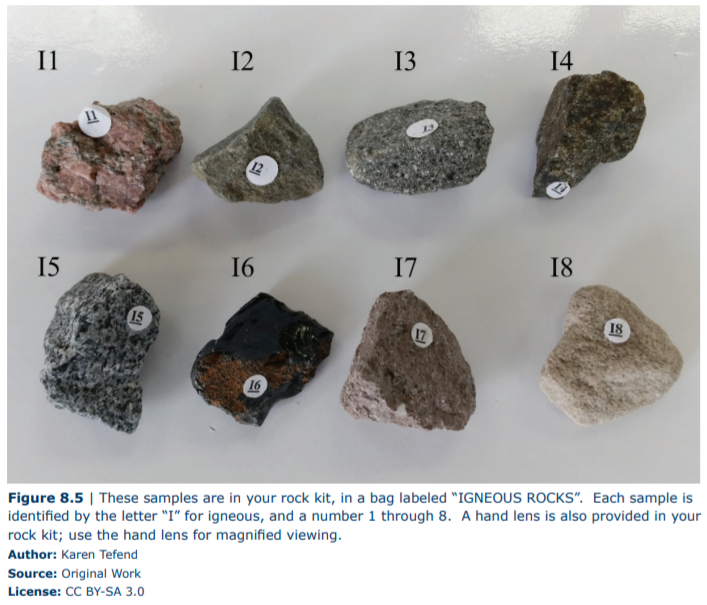8.4: Lab Exercise (Part A)
- Page ID
- 5598
Part A - Igneous Rock Composition
Before attempting to answer the following questions, remove the eight rock samples from the Igneous Rocks bag in your HOL rock kit (samples I1 – I8) and place them on a clean sheet of white paper. Your samples should look identical to the samples in Figure 8.5.
Separate the 8 samples into three groups based on their color (dark, light or intermediate). As a first attempt at classifying rock compositions based on color, most students end up with three light-colored rocks (felsic), two intermediate rocks, and three dark-colored rocks (mafic). There actually are only two mafic, two intermediate, two felsic, and two other rocks that we have yet to discuss. However, leave your samples as they are for now. Take a close look at the dark-colored rocks in your mafic pile; how are they different? When you hold them closer to a light source, notice how they reflect light; one is dull-looking, one has small shiny surfaces, and one is extremely shiny and smooth. The one that is very smooth and shiny is not a mafic rock even though it is dark in color. This particular rock is an example of that rare rock type that lacks minerals (crystals). Instead, it is almost entirely made of glass and is most probably felsic in composition. Go ahead and move this rock to its own space on your piece of paper. Now, take a close look at your three light-colored felsic rocks. One will have several minerals visible that you will see as different colors. The other two rocks will be fairly uniform in color; one is composed of very tiny minerals that require a microscope to view them, and the other rock seems to be fragile and lightweight. This fragile appearing rock is another example of rock that is again almost entirely glass with a very few, tiny phenocrysts; set this rock aside with your other glassy rock. Now you should have four piles, with two rocks in each pile, and you can now proceed with the following questions. You may want to refer to Figures 8.1 through 8.4 to help with identification.

1. Sample I1 has what mafic color index (MCI)?
a. 0-15% MCI
b. 16-45% MCI
c. 46-85% MCI
d. >85% MCI
2. Sample I1 has pink-colored minerals present, which are most likely _________.
a. quartz
b. biotite
c. orthoclase
d. Ca-rich plagioclase
3. The small, dark-colored minerals in Sample I1 are most likely _________.
a. quartz
b. biotite
c. orthoclase
d. Na-rich plagioclase
4. Sample I1 belongs to which igneous rock classification?
a. ultramafic
b. mafic
c. intermediate
d. felsic
5. Sample I2 has what mafic color index (MCI)?
a. 0-15% MCI
b. 16-45% MCI
c. 46-85% MCI
d. >85% MCI
6. Sample I2 belongs to which igneous rock classification?
a. ultramafic
b. mafic
c. intermediate
d. felsic
7. Sample I3 has what mafic color index (MCI)?
a. 0-15% MCI
b. 16-45% MCI
c. 46-85% MCI
d. >85% MCI
8. Sample I3 belongs to which igneous rock classification?
a. ultramafic
b. mafic
c. intermediate
d. felsic
9. Sample I4 has what mafic color index (MCI)?
a. 0-15% MCI
b. 16-45% MCI
c. 46-85% MCI
d. >85% MCI
10. Sample I4 belongs to which igneous rock classification?
a. ultramafic
b. mafic
c. intermediate
d. felsic
11. Sample I5 has what mafic color index (MCI)?
a. 0-15% MCI
b. 16-45% MCI
c. 46-85% MCI
d. >85% MCI
12. The white minerals in Sample I5 are most likely ______________.
a. quartz
b. biotite
c. orthoclase
d. plagioclase
13. Sample I7 has what mafic color index (MCI)?
a. 0-15% MCI
b. 16-45% MCI
c. 46-85% MCI
d. >85% MCI
14. According to Figure 8.1, Sample I4 will never contain which mineral?
a. olivine
b. pyroxene
c. amphibole
d. quartz
15. According to Figure 8.1, Sample I7 must contain which mineral?
a. olivine
b. pyroxene
c. amphibole
d. quartz
16. According to Bowen’s Reaction Series, Sample I5 (if heated) should start melting at what temperature?
a. ~1100 °C
b. ~900 °C
c. ~800 °C
d. ~500 °C
17. According to Figure 8.1, when Sample I1 is heated, what is the first mineral to melt?
a. olivine
b. Ca-rich plagioclase
c. potassium feldspar
d. quartz


